Last Saturday the Westside Critical Mass ride was pulled over by Hillsboro Police Department officers. The group of about 15-20 riders was headed westbound on East Main Street between NE 6th and 7th. Participants in the ride believe the stop was unnecessary and have filed a complaint with Hillsboro PD.
To learn more, I spoke with Washington County cycling advocate the Westside Critical Mass organizer Rob Lewis (watch a video of our conversation below). Lewis volunteers with Ride Westside and he’s the founder of the Westside Bike Happy Hour. Lewis wasn’t on the ride, but as a leader in that community he’s spoken to a number of folks who were there.
“From what I hear, the police were a bit aggressive and came in kind of hotheaded,” Lewis shared with me Thursday. Thankfully, he added, the ride leaders handled the interaction well and were able to deescalate the situation. How? They were calm and prepared.
“The ride leaders politely explained that the group was riding lawfully. They referenced the legal rules (ORS 814.430), which they carry as a sticker on their bike just for quick reference,” Lewis explained. “They were able to pretty much flip the script on the cops and they actually collected the business cards of two officers involved and then filed a complaint with the Hillsboro PD.”
I also heard from a rider named Don, who was on the ride and interacted with the officers. He told me the officers behavior was, “Pretty condescending.” “I could tell his only motivation was to extract us from the roadway — he was very adamant that we pull off the road. He had the typical holier than thou attitude and told us we were not allowed to block traffic, which I told him was incorrect.” Don told the officers they had no right to stop the group.
Don told me he worried the officer might escalate the situation and could tell he “didn’t appreciate my attitude” so Don stayed quiet after the initial exchange and eventually the officer let them go.
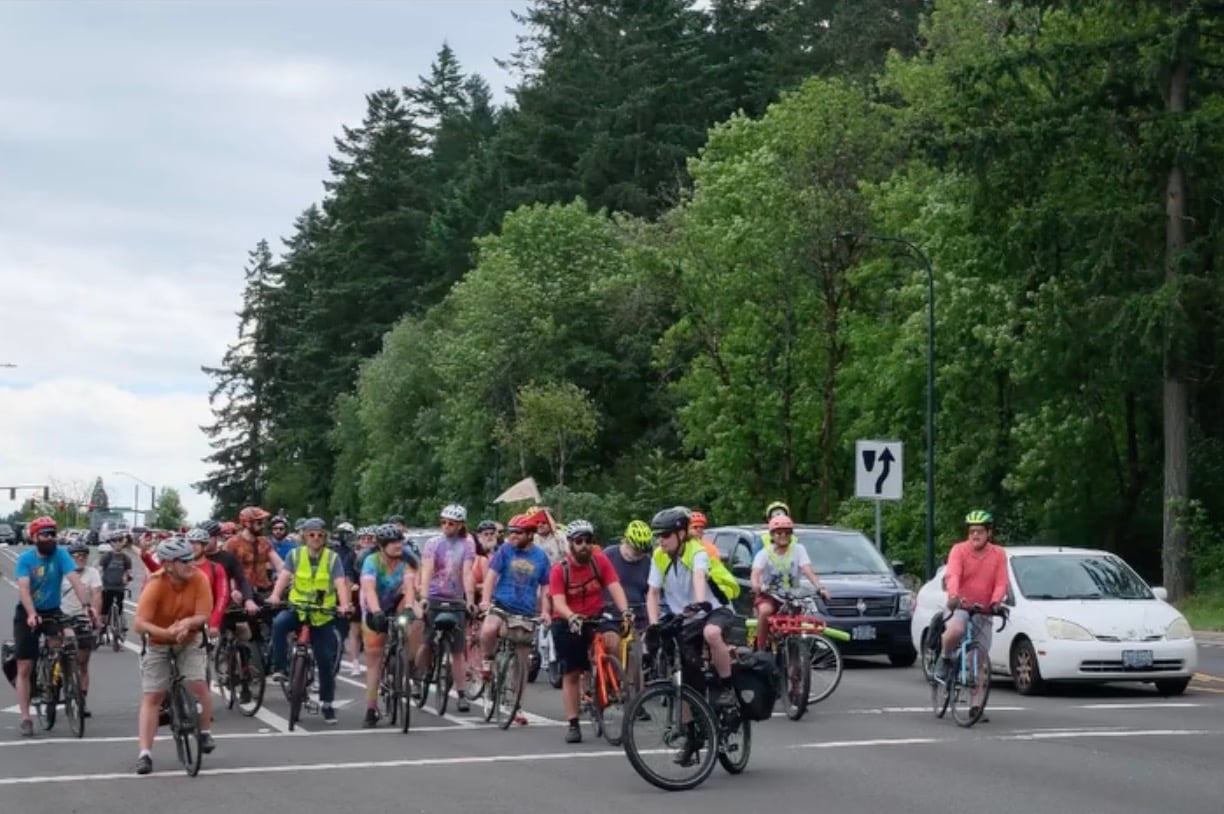
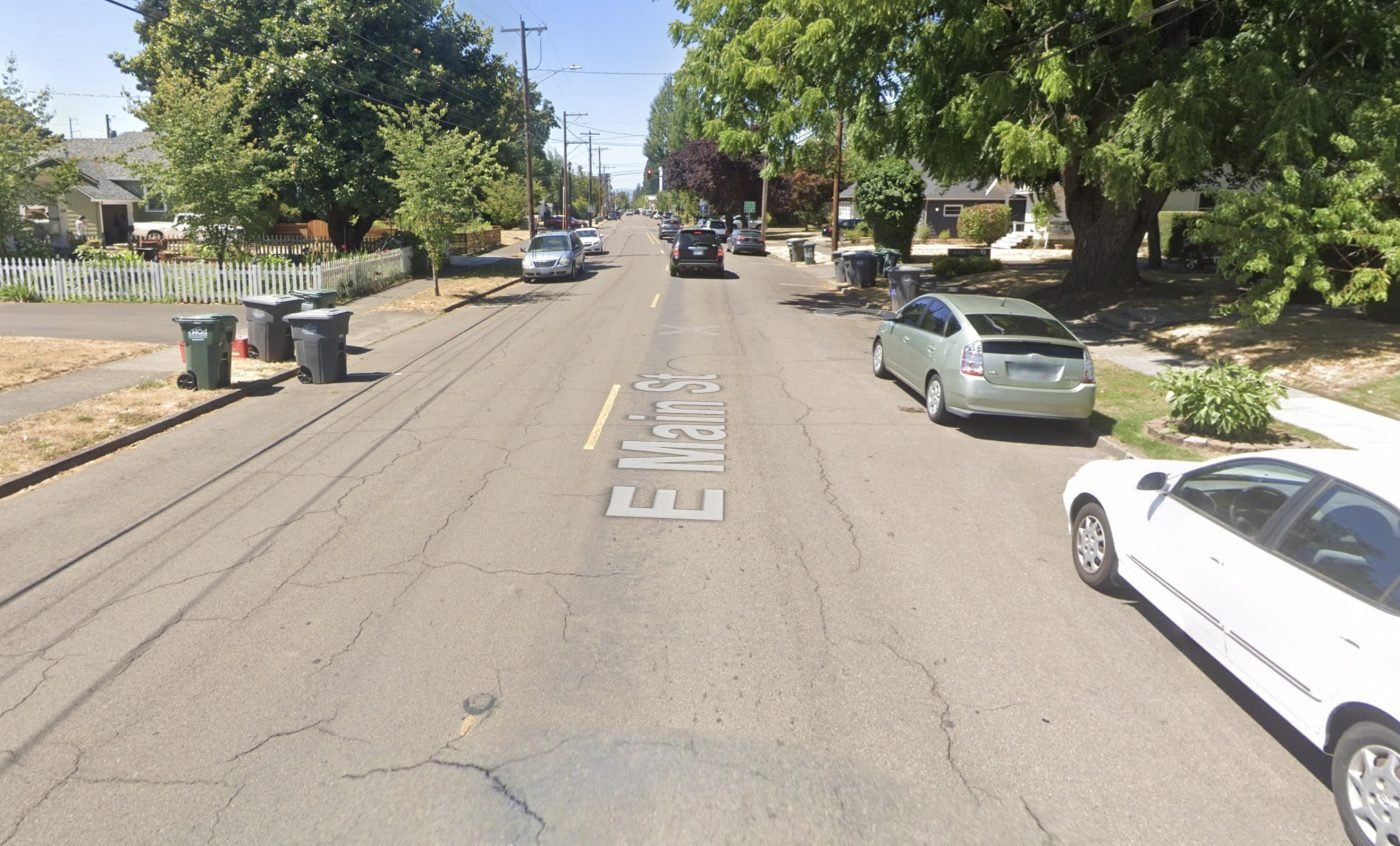
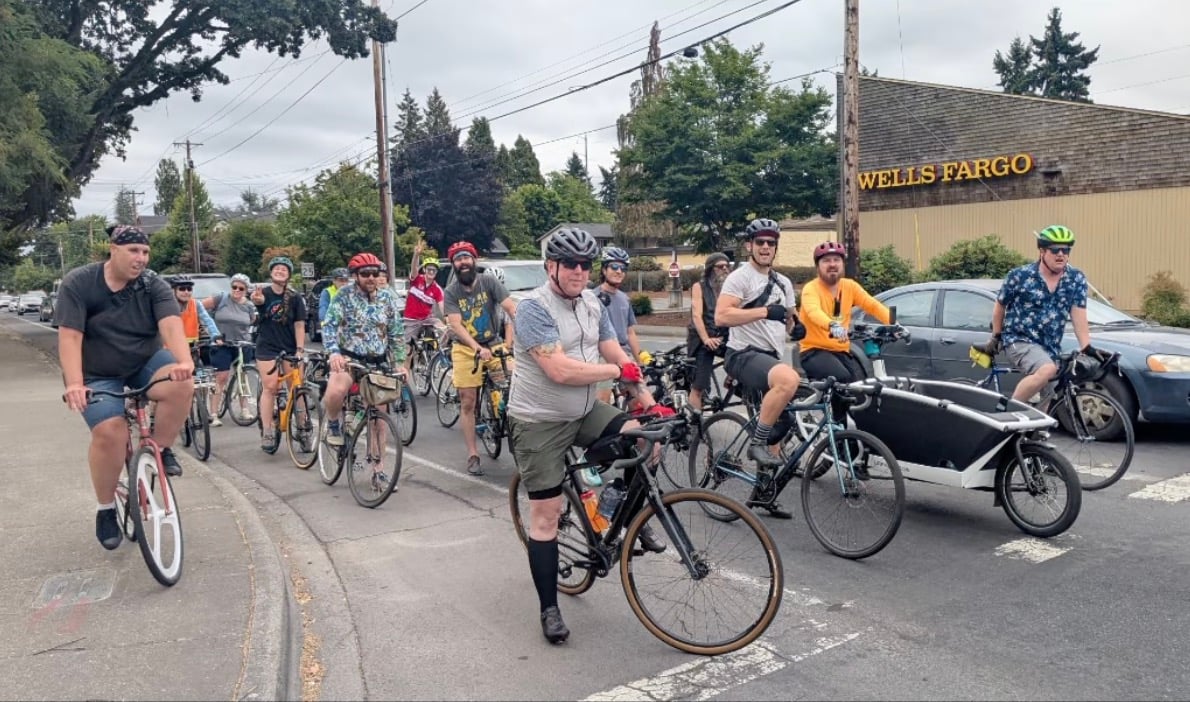
Westside Critical Mass began this year and was on its fifth ride. Initial turnout was about 50 people, but the ride last Saturday was less than half that size. Lewis says the group was near the end of a 10-mile route from Beaverton to Hillsboro. E Main St, where they were pulled over, is a relatively small road with two general travel lanes and parking lanes on each side. There’s no bike lane, so there’s no other place where the riders could have gone. It’s a very clear-cut example of when it’s perfectly legal for bicycle riders to use the full lane.
Lewis believes the officers just wanted to harass the group. “As soon as the cops realized they were in over their head and the riders knew the law better than themselves, their tone changed,” he shared. “They were immediately like, ‘Oh, well we’re here to make sure you guys are riding safely and, you know, we’re looking out for you.'”
“We just want to show the show that the West Side community is full of cyclists and that we deserve safe infrastructure.”
– Rob Lewis, Ride Westside
Unlike the huge crowds and tense police interactions that characterized Portland’s Critical Mass back in its heyday, the Westside Critical Mass has always had more of a fun, party vibe (its official name is the Westside Critical Mass Party Ride). Lewis said a mix of folks show up: They’ve had high schoolers, folks in their 50s and 60s, and a wide range of bikes — from singlespeeds to family cargo bikes. The goal of the ride is as much about building community and spreading the joy of cycling as it is about pushing for political change. They usually meet at a bike shop where the owner hands out free coffee and donuts.
“We just want to show the show that the West Side community is full of cyclists and that we deserve safe infrastructure,” Lewis said.
As for the police, Don said he spoke to a HPD sergeant (who “seemed receptive”) and let them know more education of officers is needed.
Westside Critical Mass is about having a good time riding bikes. The ride follows a loud speaker playing music carried in a cargo trailer. Don is glad the encounter with police didn’t turn out worse. But, he added, “The whole encounter put a damper on the enjoyment that the group has felt up until that point.”
— Get plugged into all things cycling in Washington County at Westside Bike Happy. It meets at BG’s Food Cartel just steps from the Beaverton Central MAX stop every second and fourth Monday. Next gathering is October 13th. Find more details on the Shift Calendar listing.

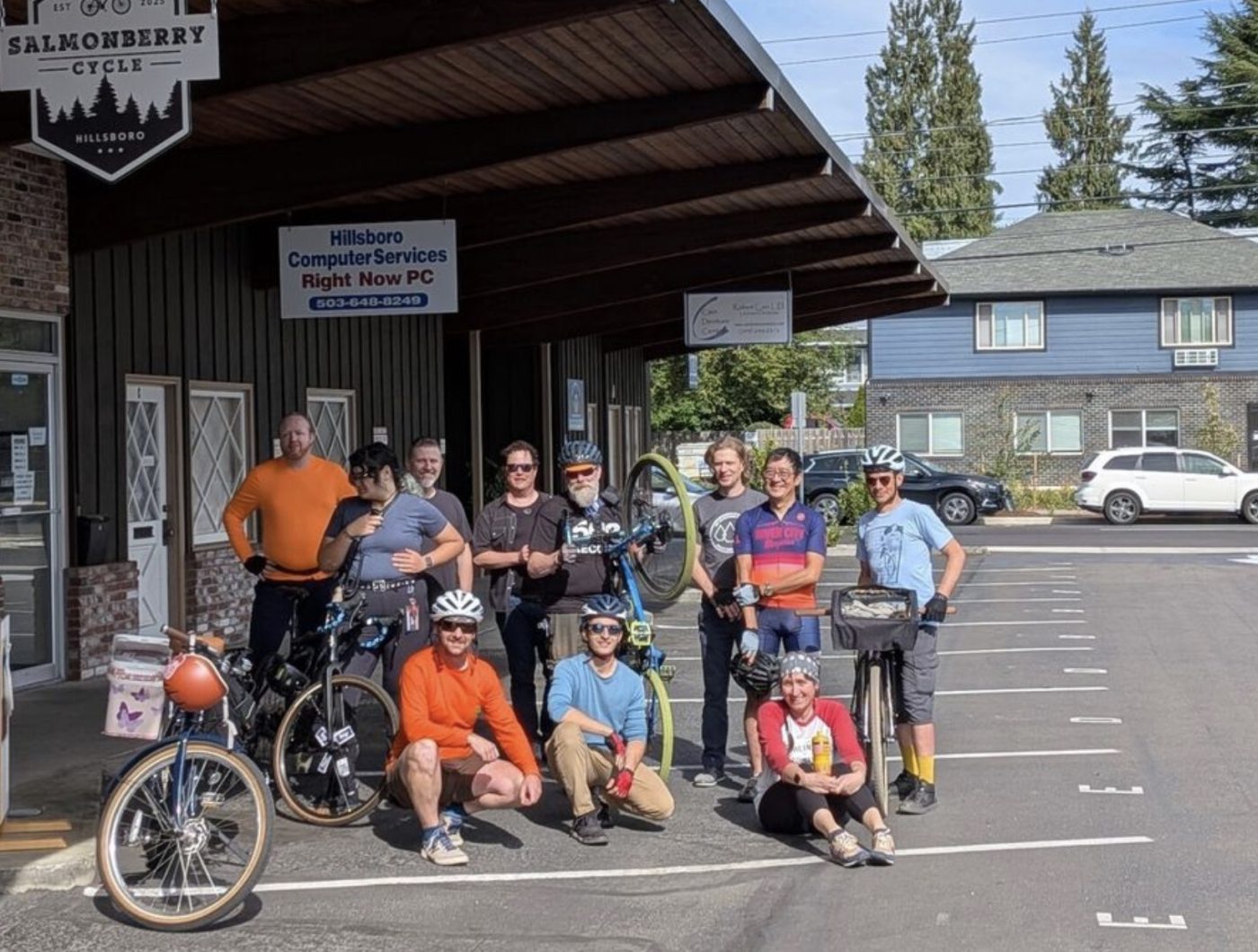
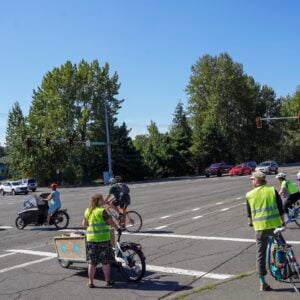
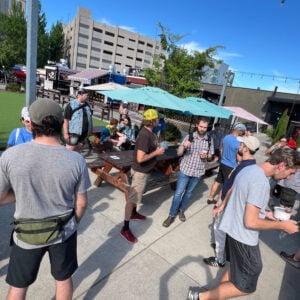
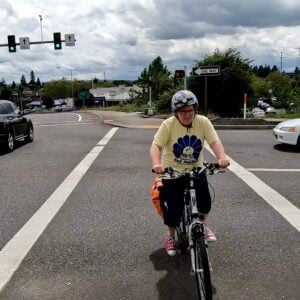
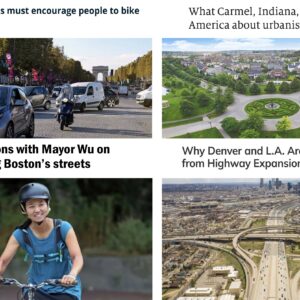
Thanks for reading.
BikePortland has served this community with independent community journalism since 2005. We rely on subscriptions from readers like you to survive. Your financial support is vital in keeping this valuable resource alive and well.
Please subscribe today to strengthen and expand our work.
What did the sticker say?
I assume it has something that references ORS that pertain to bicycling, including ORS 814.430 which stipulates when bicycle riders are allowed to use the general lane of travel. https://oregon.public.law/statutes/ors_814.430
It might be good to have/make/get some of these to be available.
Its much easier to deescalate when you have facts and codes in hand.
And understand them as well or better than them when they are overstepping.
I also think we may a pattern of this as the legal climate heats up in general.
Some maybe emboldened with the presence we’re going to be seeing and they don’t want to be seen as soft in general.
https://microcosmpublishing.com/catalog/stickers/570?srsltid=AfmBOoqG1sJoTexNkfJr7F2zPq-P-DxkAi_Cc8QrocnrQ1jJlgu-V2hP
Tx Shawn? but that link just gives the statute # on a sticker.
This type of situation would require a good working understanding of it and the ability/confidence to use it as a foil when it goes South.
A Layman’s common sense grasp like may have been used here is key I think.
I thought this was pretty helpful: https://bikeleague.org/bike-laws/state-bike-laws/?bikelaw-by-state=oregon
The photos show illegal riding, according to the legal citation you provided. I believe it is not legal to ride more than two-abreast (except, possibly, when passing), and only then when it doesn’t impede the ordinary flow of traffic.
I’m generally very sympathetic to CM (apparently no longer leaderless!), but it is difficult to have a group ride that doesn’t run afoul of this law.
It would be interesting to hear from the group which part of the law they believe shows they were legal. And if they had a conversation with the cops about that specific section..
Take a look at Section 2C (the section noted on the stickers that adventurepdx linked to in their comment above):
https://oregon.public.law/statutes/ors_814.430
“Section 2C”
You mean the section that says you can move away from the curb to avoid hazards? Is that what the folks in the photos are doing? Even if it is, it doesn’t invalidate anything I said, none of which was based on lane position.
The riders pictured are not following the law.
Qqq
Here is section 2C. I’m not sure I follow what you are saying….can you elaborate….
When reasonably necessary to avoid hazardous conditions including, but not limited to, fixed or moving objects, parked or moving vehicles, bicycles, pedestrians, animals, surface hazards or other conditions that make continued operation along the right curb or edge unsafe or to avoid unsafe operation in a lane on the roadway that is too narrow for a bicycle and vehicle to travel safely side by side. Nothing in this paragraph excuses the operator of a bicycle from the requirements under ORS 811.425 (Failure of slower driver to yield to overtaking vehicle) or from the penalties for failure to comply with those requirements.
Yes. First, I have doubts myself that the riding is legal. That’s why I said “take a look” without saying it proves anything one way or another.
Earlier, I didn’t know which specific section riders were referring to, then I saw from a comment and watching the video that it was 2C, which is why I said to take a look at it.
My thinking is that if several riders think that section allows the riding they did, AND the police may have agreed, it’s worth looking at. I realize the police may not have been convinced by the riders–they may simply have decided there was some ambiguity the riders were wrong, or even thought the riders WERE wrong but it wasn’t worth citing them.
If I were trying to make the case that the riders were RIGHT (without hearing them explain it themselves, which would be best) I’d say, well, that they were OK riding in the lane because not only were there parked cars present, there were also other bicycles (listed as a condition that excuses not staying to the right). It doesn’t say you have to be passing to move left of other bicycles, it just says you have to be avoiding them, which was certainly true.
It also says one condition needing to be present is that the lane or roadway be too narrow for a bike and vehicle to travel safely side by side, which seems true from looking at the photos.
It also says “REASONABLY necessary to avoid hazardous conditions” (the parked cars and many other bikes). It doesn’t say “in the rider’s opinion” but on the other hand, the fact that the riders seemed to believe that could convince a police officer that this is a “grayer area” citation than, say, giving someone a ticket for speeding or running a stop sign.
The section also mentions having to follow the law about yielding to overtaking vehicles, but the video explains that there was an adjacent lane that would allow passing by overtaking vehicles, which I think means the riders satisfied that yielding requirement.
I don’t know if any of that is legally correct, or if it matches with the riders’ position about 2C, and I’m not saying there aren’t arguments against it. It’s just my shot at trying to understand why they MIGHT be right. I’d love to see a bicycle-focused lawyer discuss it.
Me too. There seems to be quite a range of perceptions of what is legal and not in terms bicycles on public roads. While legality is not really a primary concern of mine when I’m riding (I think reasonableness and consideration are more important than the letter of the law), it would be nice to have a clear picture of the law. I don’t think road users have a generally clear understanding of traffic law. More distressing, it’s not clear that the engineering organs (PBOT, ODOT, counties, etc.) or even law enforcement does, either.
Yes to all that. Just look at the differences of opinion here–all by people who really analyze these laws. Even for me, when I’m saying what the arguments that the riders were legal could be, I’m not saying those are the only interpretation, or even necessarily the correct one.
And–as has come up often with other cases–even if your chances of getting cited are tiny, it can make a huge difference if you get injured and try to get covered by insurance.
The timing of this article is uncanny – this morning on my way to work, a PPB cruiser raced in front of me so they could park in the bike lane. I assumed good intent and thought maybe they were responding to a call. Turns out they just needed to get coffee. As they got out of the cruiser – without checking before they opened the doors lol – I got a side-eye and a “have a safe ride” from one of the officers as I changed to one of the vehicle traffic lanes so I could go around the parked cruiser. You really can’t write better satire than reality provides.
It’s really good that the ride leaders stayed cool but called the cops out on their bullshit. I’m sure that “more education” won’t change the attitude and culture of Hillsboro PD, or any other PD for that matter, because it’s ultimately a reflection of our car-brained American culture. Also the “blocking traffic” thing is so funny to me, like literally out of a Facebook comment section.
Sounds like the ‘olde’ days in Vancouver USA 2000s…used to be the Vancouver “Uncritical Mass Ride”. The police HPD interaction sounded similar to when VPD pulled over a similar sized group of riders riding legally 2 abreast in the curb lane on a 4 lane road. (This section of East Fourth Plain just east of I-5 in front of the County Health Dept / VA Center – 20 years later – now has a protected bi-directional bike track.)
?? Google aerial and street views do not appear to show any kind of bike facility, let alone protected, on East Fourth Plain east of I-5..
The bike track has recently been completed and won’t likely show on Google photos. Come ride Fourth Plain. It’s beautiful.
Many thanks to Rob and Ride Westside for amplifying the conditions riders are faced with on the west side.
I love the look on Jonathan’s face when they’re discussing the route from Cascade to Salmonberry because there are just big, fairly treacherous gaps in what should be a fairly straightforward 10-mile ride from Cedar Hills to Downtown Hillsboro. But that Jenkins/Baseline stretch is still designed largely for high-speed vehicles.
And then Main, where the group was pulled over? Single riders get nothing but grief there constantly despite it being the primary route into downtown. Hillsboro has had a difficult time wrapping its mind around cohesive bicycle infrastructure: Putting well-intended and often effective cycle tracks for leisure riders in certain neighborhoods (Jackson School has reinvigorated that neighborhood and increased casual bike traffic downtown) while letting entire sections of the city go fallow.
And Rob is right: You’ll have cyclists here cite the bike lanes on Evergreen as some of the best in the city, but it’s two stripes of paint between Intel bike teams and dump trucks from data center construction sites going by a 50 miles per hour.
It’s commendable that the city actively looks to pinch Oak and Baseline through downtown and make them more bikeable, but Washington County as a whole does little to connect its map and make it easier for cyclists to travel by bike alone. I’d like to think that seeing more cyclists around would help the HPD and others acclimate to their presence. But that’s a tough ask when your cities still contain orphan highways, unprotected ditches, and urban centers lacking even basic bicycle infrastructure.
Notteham, Yeah you hit the nail on the head…it was interesting when Hillsboro staff hired my consultant team to explore – lessons learned from other cities – making their downtown highway centric couplet arterial loop back into a two way operations…back ~15 years ago…the then council just shut it down. Never really heard a good reason why. ;-(
In one of those images, I see a group of bicycle riding “legal experts” blocking a right turn lane, a crosswalk, a full traffic lane, and a lead rider violating the intersection, possibly impeding cross traffic at a spot where bike infrastructure is very clearly available.
In another, riders are again massed outside of the provided bicycle infrastructure and on the pedestrian right-of-way.
The cops were wrong in this circumstance and need more education. Let’s not ignore that these riders are also not living up to the letter of the law. Does that not matter because the intent was benign fun and advocacy? I’ve been doing large group rides in Washington County for over 20 years. Not only have we had no issues with local police or sheriff’s deputies, but they are also very responsive when we have phoned in dangerous drivers, possibly intoxicated drivers, and when harassed by motor vehicles on Washington County roads. I don’t wish for that goodwill to disappear because some loose group of advocates got BikePortland to deliver a second dose of humiliation.
Remember, in these forums, if you are a bicyclist, you can break any law you want.
If you are an auto driver, just your mere existence is against their “law” and subject to tar and feathering irrespective of what you did.
Yet you’re replying to a regular commenter who just criticized the bicyclists, and there are other comments above by regular commenters who are questioning the legality of the bicyclists’ riding.
At least you didn’t say “echo chamber”.
It’s possible to have smaller, differential echo chambers within a larger echo chamber. I think?
But how are these echo chamber elaborations relevant to what happens here in the bikeportland comments? I have long found this term tiresome since what actually happens here is nothing like an echo chamber. Disagreement, drilling down, trying to figure out where we may agree is why I come here. That is how I learn new things.
So, you’re asking me if within a large group of people that all think the same, you can have a smaller group that thinks differently?
“Remember, in these forums, if you are a bicyclist, you can break any law you want.
If you are an auto driver, just your mere existence is against their “law” and subject to tar and feathering irrespective of what you did.”
Your comments here are hilarious. You and Trump: same playbook. Take something with a tiny kernel of truth (folks here can give bike riders a pass when really that is not warranted) and spin that into a full-on ridiculous black-and-white blanket statement. So unhelpful. How does writing something like this lead to greater understanding? What is to be learned from something like this?
Surely context, not to mention a history of bias, lopsided enforcement, carhead, laws-that-exonerate-drivers, not to mention differential risk all come into play here. It isn’t as if those piloting cars, or law enforcement, had nothing to answer for. Your comment skips over all of that, unhelpfully flattens a very lumpy history and terrain.
I’ve lived in several different states and had assumed that each state had different laws for bicyclists, but gradually I’m realizing that most states have pretty much the same laws but different enforcement mechanisms.
An example is Oregon’s “unmarked crosswalks” law. It turns out that nearly every state that I’ve looked up has the exact same law but most residents (and specifically most law enforcement officials) are completely unaware of it. The feds effectively required every state to adopt such laws as part of the 1992 Americans with Disabilities Act (ADA). North Carolina, where I currently live, has more or less the same exact wording as Oregon, and effectively the same lack of enforcement on it.
A second example, I was once pulled over by police in a city in North Dakota for not riding on the “sidepath”, the narrow weed-infested sidewalk along a busy 4-lane arterial. Later I talked with several city officials who pointed out that while ND did in fact have a “sidepath law” (which Oregon and many other states also have), it’s only enforceable on certain specific streets, those which are clearly identified on state DOT maps on a state master plan, which is revised annually, and the street that I happened to be pulled over on used to me on the ND state map a few years previously but was no longer on the map, and therefor what I was doing (riding in traffic) was perfectly legal. They, the city officials, then contacted the police, who later apologized to me (if nothing else, North Dakotans are very polite people, even the police).
If I understand this article correctly, it is entirely based on information provided by someone who wasn’t there? If that is true, then this is not journalism, it is gossip. If you wanted to report accurately, maybe call someone who was actually on the ride? Very disappointing.
Steve. The story includes quotes from someone who was there and who spoke directly w the police. Please read more carefully before insulting me.
Steve did not, in fact, understand this article correctly.
I re-read the article several times and it is very confusing, at least to me, who is speaking. Is it Don, Is it Lewis, Is it Jonathan? You go back and forth so much it is very difficult to tell. Then, you said, without quotes that “Don told the officers…”. You actually have no idea what Don said to the officers, unless you were there. What is true is that Don told you what he told the officers. For all you know, he screamed at the officers….your lack of precision is obvious, and undermines your reporting. I did not insult you. I was accurate and you were not. OK, I was not totally accurate…the piece was based on some first-hand information and some second-hand information, without clear differentiation of which is which. It only takes a sentence or two of misreporting for the credibility of any piece to be weakened. This is so common in the media nowadays….building an image of an event around some facts and some unverified information. The reader is therefore left with creating truth on their own, usually out of a preformed bias. Nobody is well served.
Steve, I’d put more stock in your comments if you didn’t only show up when you have an extremely biased take on JM or anything on bikeportland.
Here’s a simplified guide to ORS 814.430 — Improper use of lanes (for bicyclists in Oregon)
Basic rule:
Exceptions (when you don’t have to stay on the far right):
Things to keep in mind:
Related to this, I read somewhere that sharrow symbols painted on the pavement indicate the location within a lane that a bicycle may occupy. These are most often located in the middle of a lane. If so, it seems contrary to the exceptions shown above. Can anyone clarify?
Sharrow markings do not supersede state law regarding lane position, however, on the streets where are you are most likely to find them, riding in the indicated position is legal because there is insufficient room to safely pass, there are parked cars that prevent you from riding close to the curb, etc.
On a practical level, if you follow the sharrows, you will be fine.
An insider at PBOT says the Sharrows were not reviewed by any engineer but were put out at the insistence of one of our previous elected leaders a number of years ago that wanted to copy some City they visited and didn’t want to wait for proper engineer review.
Hi Solar,
Sharrows were approved in the US MUTCD’s 2009 edition.
Then installed in large numbers in Portland starting in 2010.
PDOT correctly followed the installation drawings in the MUTCD.
Perhaps the story you heard related to the “directional sharrows” which were not in the MUTCD but were installed anyway. The “directional sharrows”, whether approved by engineers or not, were installed in a way that was clearly “uniform” in appearance and meaning as the standard sharrows. So are in compliance with the “uniform traffic control devices” intention of the Manual on Uniform Traffic Control Devices. And still work fine 15 years later.
Cheers, and hope to chat with you at Bicycle Happy Hour sometime,
Ted
According to our local traffic engineers here in Greensboro NC who are sticklers for following federal guidelines and the MUTCD, the sharrow symbols are supposed to be placed exactly where the traffic engineers believe that a cyclist will be safest in traffic – away from the door zone, on smoother pavement, away from the gutter, etc – but they are also placed to slow car traffic, that like painted bike lanes and city buses, bicyclists themselves are being “used” as traffic calming devices, to slow car traffic to the prescribed speed limit.
When I explained how Portland uses sharrows to instead of traditional bike symbols to show the routes for bicycle boulevards (bikeways), our engineers were appalled – the sharrows are designed to only be used in limited circumstances, in mixed traffic only, not on low-volume residential streets nor on high-volume high-speed stroads. They are supposed to be used sparingly, that there are other much more appropriate symbols out there including the regular old bike symbol.
David — I also cringed in 2010 when they launched the “wayfinding sharrows”.
But I figured I’d wait and see how they worked out.
And they’re pretty good.
Nothing in the mutcd specifies which roads get them, if I recall correctly.
But they provide a handful of very useful services here in Portland, Oregon. You can pass this on to your peers in Greensboro:
* they encourage all riders to take the middle of the street.
* this is out of the door zone.
* this is out of the “gravel and glass” zone.
* this provides bicycle users the earliest possible view of cross traffic and pedestrians.
* this provides motorized cross traffic the earliest possible view of oncoming bicycle traffic,
* they are big and splashy. Unlike the 18” medallions they replaced.
* they train unfamiliar drivers to know that a sharrow means “bicycles belong. Right here”. And thus helped unfamiliar drivers learn what sharrows mean in busy streets in other cities. (Back in the early teens when sharrows were new in many places).
Apologies for thread drift.
Ted Buehler
Ted, from talking with our local engineers, what they want is to grow our existing minuscule bicycle commuter mode share (less than 1% in Greensboro), which most US cities do by expanding arterial protected and buffered bike lanes between important origins and destinations. Their critique of Portland’s bike boulevards is that the residential bikeways essentially trivialize and make “recreational” what used to be Portland’s really strong bicycle commuter population. Portland wayyy overuses the sharrows on the wrong streets. By encouraging (forcing) riders to use back streets and not ride on arterial roadways, the City of Portland has abandoned its natural obligations to give bicyclists equal status on major roadways – they’ve pretty much made bicyclists second-class roadway users, for recreational purposes only – rather than primary bicycle commuter users. And unfortunately most Portland bicyclists have embraced this change. Our engineers see the decline in Portland’s bicycle mode share was directly caused by the city’s policy to push bicyclists to low-volume residential streets rather than upgrade collector and arterial streets to make them more bike-friendly and safer for bicyclists, and you can see that in the PBOT budgets. And our city would prefer to not make those same mistakes, but rather to follow the example of Charlotte NC and gradually upgrade arterial bikeways as they are able and avoid creating backstreet recreational bikeways.
“And unfortunately most Portland bicyclists have embraced this change.”
I ride to get places (not so much recreationally), and I strongly prefer biking on quiet leafy residential streets to riding along arterials (even where facilities are good). So count me among the embracers.
For all US cities, “Mode Share” refers just to people who travel from home to work in whatever mode, with a very limited selection (bike, walk, transit, work from home, van pool, and drive alone), on a US Census survey called the American Community Survey. It doesn’t allow for more than one mode. And it’s based on a survey with random respondents, so it’s actually an even smaller sample. Apparently in the 1990s Portland at one point had over 7% of daily commuters traveling by bicycle as their primary mode, from home to work and back again, a mode split that is unusual for most large US cities but common enough for small college towns.
From the academic literature on the topic and from what I’ve observed, those who bicycle at all vastly exceeds those who bicycle from home to work on a daily basis, in all communities. Your statement “I ride to get places (not so much recreationally)” reflects this, as does my own riding. But the only bicyclists who really count for city planners and engineers are those who bicycle to get to work, and even then, those who do so as their primary means of getting to work, and further, those who respond to the survey – in other words, a really tiny random sample, even in Portland. So if you want to increase your bicycle mode share (and most US cities really do want to, if only for bragging rights), you pretty much have to cater your system to this very small segment of your bicycling population.
David — I looked it up.
https://mutcd.fhwa.dot.gov/pdfs/2009/part9.pdf
See section 9C.07 (I can’t copy/paste from some reason).
Pass it on to your colleagues — Sharrows are A-Okay for neighborhood greenways / bicycle boulevards.
Solar — any other comments on Sharrows?
Ted Buehler
Just remember, in regard to the presence of other bicycles, that they don’t just appear in that summary as a reason to not have to stay to the right here::
They also appear in:
The summary doesn’t list the conditions that are defined as hazardous, but the actual law does, and “bicycles” are listed.
So I read that to say you can move away from the right to pass other bicyclists, but if they’re present, passing them isn’t the ONLY reason that allows you to move away from the right, as I read it. Otherwise there’d be no reason to include “bicyclists” on that list of hazards.
Another thing I’ve been wondering, if the lane is too narrow for a car to pass a bicyclist–which seems to be true–and the bicyclist is riding a few feet out from parked cars to avoid being doored (car doors potentially opening in your path seem like they’d be included as one of the conditions that allow a bicyclist to ride away from the right) that would put them in the middle of the vehicle lane.
So if it’s legal for each bicyclist to be riding out from the right if they were each riding alone, why wouldn’t it be legal for several of them to be doing that at once.
If riders are in the middle of the land to avoid obstacles such as parked cars, for example, would there be room for more than two to riding side by side?
Maybe in some cases, but I think not in the general case.
Ignoring for the moment that it’s explicitly ruled out elsewhere.
On a very practical level, if you’re arguing that level of detail with a cop, you’ve already lost.
Well, whatever the people in the article argued with the cops, they won.
And if it’s legal to not be to the right in order to avoid hazards, the two-side-by-side component becomes irrelevant.
“they won”
Good point, I too wish I knew what they said. Maybe “these aren’t the bikes you’re looking for.” ?
I don’t know why avoiding a hazard would erase other requirements, but if you’ve got the force on your side, maybe it doesn’t matter.
If you meet one exemption to a requirement of a law, it’s very common for you to then be exempted from other requirements.
I always thought it was the opposite — an exception to one provision (riding to the right) does not make you exempt from others (prohibited from riding more than two-abreast).
Oh and if you want to venture north of the border…..although they’re quite similar……
Key differences between WA and OR laws:
Washington State Bicycle Road Use Summary (RCW 46.61.770):
Basic rule:
Exceptions — you can move away from the right side when:
Other notes:
I got an ORS 814.430 sticker for my bike after this ride, and a bumper sticker for my car, too. I half expect to get pulled over more often now because of it…
SB 895, effective Jan 1 2024, amends ORS 811.420 to clarify when a driver may pass in a no passing zone to include overtaking “a person who is riding a bicycle or operating another type of vehicle and who is traveling at a speed of less than one-half of the speed limit established.”
The part of Main St. where we were pulled over was a two lane residential street with a broken yellow lane divider. So even before the new law passed, any driver could have legally passed us on the left if it was safe to do so. Which it was. And in fact, many drivers did pass us in this manner west of Brookwood Pkwy, where Main narrows to three and then two lanes.
I can’t imagine the level of suburban entitlement that it takes to consider driving slower for the four blocks between Cornell and Main – where Main narrows from three lanes to two lanes – and 5th and Main – where Main becomes a two lane, one way street – an emergency situation…
Roads are for military, walkers, rollers, riders, freight, personal vehicle travel in that order. Some people in these comments want to put rolling/riding/walking before their own wheels in a vehicle and then try and use the law to do it. Nevermind that there is no protection on a bike or walking or in a wheelchair. So in essence some here are basically saying “do what the guy with the gun says and maybe he will like us”.
Stand up and get loud. Don’t give in to vehicles. They can use their brake and wait.
I suspect the state statute was not intended to support pedalpalooza/critical mass style rides.
Might be easier from a practical perspective to revert to the “this is civil disobedience” approach. “We’ve been asking for bike lanes for 20 years, it’s been 60 years since the Bicycle Bill was passed, and we are still getting killed on these roads. We’re going to take them over”.
Just a thought.
Ted Buehler
This illegal behavior is in direct violation of the strict no-politics stance of Shift and their 501c3 sponsor and would therefore be banned from listing on the Shift calendar.
Ironically, BikeLoudPDX was founded to enable this type of grassroots protest but is now also a timid city-funded corporate-friendly 501c3 that would never host an in-your-face illegal ride.
Hi Soren,
Interesting points.
So, to make a west side critical mass ride appropriate for the Shift2Bikes calendar it would need to be called something fun, rather than something associated with civil disobedience.
That’s how the Portland bike scene shifted in 2002 — no more militant critical mass rides, just fun nonconfrontational rides that also took over the streets….
Somewhat true about BikeLoud. Though it is also suing the City of Portland. So it’s not a total lapdog….
Ted Buehler
I think that refers to Shift officially endorsing a political viewpoint as an organization. They are allowed to display community-created politically motivated events on their calendar which does not constitute an endorsement.
There are already many politically motivated rides and protests listed on Shift, including protests for Palestine, the WNBR as a protest of the fossil fuel industry, protests rides against ICE, protest rides against PBOT or ODOT, the list goes on. Shift simply doesn’t officially endorse them as an organization, as long as they are neutral it’s fine.
Shift would not host certain direct actions on their calendar back in the grassroots days of BikeLoudPDX. Perhaps they do now…
Take a look at the Shift Code of Conduct, there is nothing blocking political or protest rides from being posted:
https://www.shift2bikes.org/pages/shift-code-of-conduct/
On one hand, cops and motorists sometimes harass cyclists citing nonexistent laws. The flip side of that is cyclists believing the law is whatever they interpret it to be or can use language within it as a pretext to justify whatever they like.
The photos show cyclists blocking everyone — walkers, cyclists, anyone turning right or going straight. That isn’t legal but it is obnoxious, and an appropriate baseline expectation is to receive the courtesy you show others. I am curious what happens when other cyclists encounter a group like that, because they make a clean pass impossible?
If I encountered a group like that, I’d exercise a legal option to get through quickly that would encourage them to reflect on their choices of the moment and show more consideration to others in future.
Baloney. Every cyclist knows that cops don’t stop you to keep you safe – they stop you to keep you in line, which means: out of the way of cars.
I’ve personally been pulled over by cops a dozen-ish times in my 50+ years of riding all over the USA, and never once have I felt that the cop was doing it to “keep me safe.” It was all about busting my chops for making things tougher for drivers or just finding an excuse to harass a cyclist for some petty, stupid thing like stopping my bike a few inches beyond a stop line (so I can see into an intersection to make sure it’s safe).
Once as I was riding my bike up a hill in New England, a cop came up behind me and blasted me over his loudspeaker, telling me to “Get off the road and onto the sidewalk.” Which was wrong, but whatever. I’ve never once felt a cop is “keeping me safe” as a cyclist. It’s always about putting me in my place – the doghouse.
Anyone who wants to debate the legal-ness or not of the ride, please come speak with me and the group at the Westside BHH. I am happy to chat about it.
The whole point of the ride is to raise awareness of the gaps in regional infrastructure and to bring the cycling community together to celebrate cycling on the Westside.
In the interview, I have clarified the point of “at the time the group was stopped, the group was riding legally.”
I also clarified in the interview that we might not be riding legally elsewhere on the ride, but what we do during the ride is done to ensure the safety of the group.
Are we corking the ride? Absolutely; for the safety of the participants.